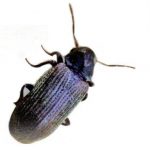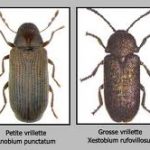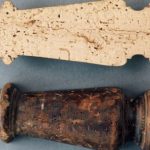Votre panier est actuellement vide !

The beetle
The adults of the furniture beetle (2.5 to 5 mm) and the death watch beetle (5 to 7 mm) have a massive and globular body, and their head is hidden under the thorax in the shape of a cap.the small furniture beetle has an elongated shape and is of chocolate brown color with punctuations on the elytra (the back), while the death watch beetle is more stocky, of dark brown color and has species of yellowish tufts of hairs on the elytra. Its thorax carries three pairs of legs.the adults have wings and are attracted by the light of the dayThe larva (5 to 7 mm for the small furniture beetle and up to 11 mm for the large furniture beetle) is arched, of creamy white color and covered with hairs.
Latin Name: Xestobium rufovillosum
Description :
Two species are found mainly in homes, the furniture beetle and the death watch beetle. The adults of the furniture beetle (2.5 to 5 mm) and the death watch beetle (5 to 7 mm) have a massive, bulging body, and their head is hidden under the hooded thorax. The small beetle has an elongated shape and is of chocolate brown color with punctuations on the elytra (the back), while the large beetle is stockier, of dark brown color and has species of tufts of yellowish hairs on the elytra. Its thorax bears three pairs of legs.Adults have wings and are attracted to daylight.The larva (5 to 7 mm for the small furniture beetle and up to 11 mm for the large furniture beetle)is arched, creamy white in color and covered with hairs.
Reproduction:Adults leave their galleries only for a short time. During the summerthey mate, after which they re-enter the wood, in order to lay20 to 40 eggs. The eggs are milky white and barely 0.5 mm long and the larvae hatch four to five weeks after being laid. As soon as they hatch, they form messy corridors and pierce the wood through and through. The larval stage of the furniture beetle lasts two to four years, and that of the death watch beetle three to five years, depending on temperature and other factors; for example, high humidity favors rapid larval development. If environmental conditions are not favorable, the larval stage can last up to 10 years. It has been found that the number of first generation beetles increases tenfold in ten years. The larvae bore into the sapwood, preferably into the soft, nutritious spring wood. The presence of the larvae, commonly known as woodworms, can be recognized by the sawdust that emerges from the small holes. It should be noted that the damage to wood is mainly caused by the larvae. This species owes its name to the regular « ticking » sound that the female makes when striking the walls of the galleries with her head and thorax. The damage caused to furniture, beams or old frames is considerable.In case of massive infestation, the wood falls into dust.
Habits:The beetles live naturally outside, but they are very happy in homes. They particularly attack lumber (framing and flooring), but also furniture, artwork and bookcases.The furniture beetle shows a preference for damp wood and thrives in both hardwood and softwood species. The furniture beetle can also grow in hardwoods and softwoods, but unlike the furniture beetle, moist wood is essential for its development. Moisture leads to the development of lignicolous fungi in the wood, and the nitrogen produced by the fungi as well as the water provide the nutrients necessary for its development. A minimum humidity of 22% is essential for the development of fungi and, consequently, for the development of the larva. The temperature must be between 20 and 25 °C. Of course, excessive humidity is very often linked to infiltrations (roof defects, leaking pipes, cracks in the masonry at the level of the frame, dampness due to absent or defective drainage of the foundations, poor insulation in relation to the ground, etc.). The beetles seem to spare the tropical species.
Prevention:As the beetles are attracted by wet wood, it is necessary to eliminate excess moisture in the problematic rooms. This moisture is often related to water seepagefrom the roof, piping, cracks or water damage, storms, floods, etc.To prevent infestations, the condition of the wood should be checked regularly, watch for signs of presence (exit holes, feces, presence of adults near windows),The adults of the small and large furniture beetles form exit holes typicallycircular in the wood. The exit holes of the furniture beetle are 1 to 3 mm long, and those of the furniture beetle are 2 to 4 mm long. These holes are more or less localized and numerous. It is also possible to confirm the presence of furniture beetles by observing (with a magnifying glass) the characteristic feces. The droppings of the furniture beetle are very small, cylindrical and elongated, while the droppings of the large beetle are rounder, larger and look like tiny lenses.These infestations are serious and can severely damage homes and furniture.Treatments can be applied in the home but should be administered by specialists to ensure that all sources of infestation are properly treated.

